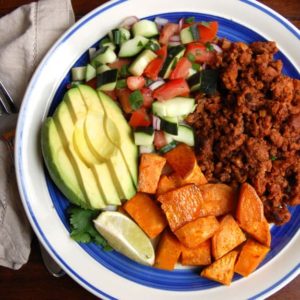Getting into Ketosis is a State of the Body Where it is Being Fueled Mostly by Fat
The source of fat can be healthy fats in the diet or the fat stored in the body. The burning of fat produces the energy for the body.
This is different than ketoacidosis, which can be a dangerous problem associated with diabetes. In cases of uncontrolled diabetes mellitus the body may not be making insulin, blood sugar is uncontrolled, and the blood could become too acidic. Nutritional or therapeutic ketosis is safe and can be achieved through a higher fat, moderate protein, low carbohydrate diet.
A great resource is the Keto Nutrition website.
I have been in ketosis three times in the last two years as demonstrated by blood testing. My first experience with ketosis I got there by what I call teeter tottering in. I slowly increased my healthy fat intake while lowering my carbohydrate and protein consumption. This was done incrementally over the course of about six weeks.
Fasting Mimicking Diet
The second time I got into ketosis with a Fast Mimicking type diet. Since my body was adapted to burning fat, I was in ketosis by day two of this plan. The Fast Mimicking type diet mimics fasting but still provides nutrition making it easier than fasting alone. Here is the link to Dr. Schmidt’s video about the Fasting Mimicking diet.
Whole30® Diet
Most recently I was in ketosis while doing the Whole30® diet. This was my most successful Whole30® because I made sure I was eating an adequate amount of fat to keep me full and well nourished.
Now, I hover near ketosis by eating low carbohydrate (50- 60 grams), moderate protein (50 – 60 grams), higher fat (80 grams) on a daily basis. Also, I intermittent fast during the week. I don’t typically eat breakfast, but I do put healthy fats (coconut oil, coconut cream, or butter) in my coffee in the morning. Because I am fat adapted I can go long periods of time without getting hungry.
My recent blood work shows that this type of diet and being fat adapted has worked for me. My total cholesterol was 192 (normal). My triglycerides were 42 (normal is 0 – 150). My blood sugar the day of the blood work was 63 (normal 60 – 109). I had fasted for approximately 15 hours before the test. I was hungry. But, not feeling any low blood sugar symptoms at all – no dizziness or lightheaded feeling, no moodiness, no problems.
Yours in health,
Kerry Cradit
Kerry is a nutrition expert that works with Dr. Schmidt at The Nutritional Healing Center of Ann Arbor. She has her degree in Nutrition and Food Science.


